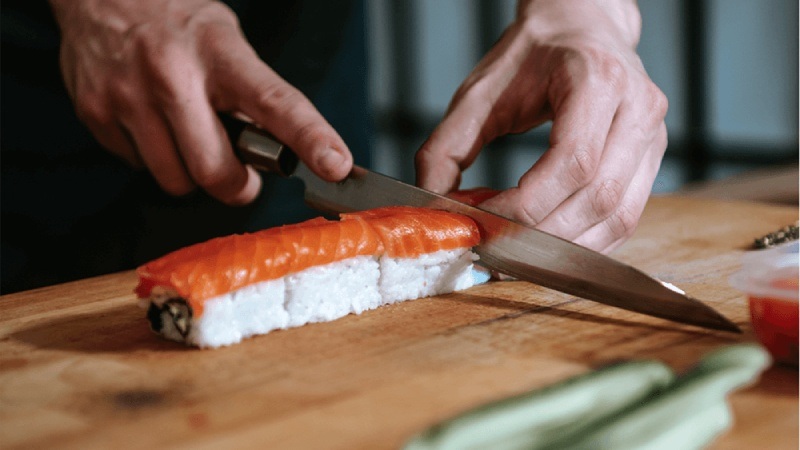
Just like in Western cuisine, where a wide variety of models and types of knives are used depending on the food preparation required, whether for peeling or mainly for different cuts of meat and vegetables, Japanese cuisine is no different. Japanese cutlery knives can be even more curious and interesting. Contrary to what many people still believe, that the chef’s knife can be used for everything, this is not quite the case.
This is because, for each type of food, there is a specific type of knife and, especially in Japanese culture, where traditions are taken very seriously and with great respect, it is no different in the kitchen. Everything must be in harmony and no flavour should stand out, since each food is linked to the other. And, depending on the need for its use, the different types of knives in Japanese cuisine can make the work of the cook or chef much easier. After all, there would be no reason to use a sashimi knife to cut vegetables, for example.
And, without a doubt, the perfect blade for easily cutting ingredients such as vegetables or fish fillets for sushi or sashimi is one of the main characteristics of traditional Japanese knives, which contributes to their special and uniqueness. This is because, in addition to flavour, oriental cuisine also values the visual presentation of dishes. That is why precise cuts are so important and can improve their visual appearance.
If you are not familiar with Japanese cutlery, but are curious to learn more about this ancient tradition, check out the most commonly used Japanese knife models and their function below:
SANTOKU
One of the chef’s knives from Japanese culture that has become popular in other countries is the Santoku. It’s not very large and, therefore, is even more versatile in the kitchen, as it is used for almost everything, from chopping vegetables to cutting meat and poultry. The Santoku knife does not have a curved blade, so the cutting movement must be vertical, which can be a little uncomfortable for unaccustomed cooks. Santoku knives are for all types of cutting, but are mainly used for slicing and chopping vegetables and meat.
Santoku, in Japanese, means “three virtues”, referring to its versatility. There are Santoku models with some reliefs, which make it easier for the vegetables to come off the blade.
GYUTO
This model is considered the true Japanese Chef’s Knife. It is for general use, both for cutting vegetables, meat and poultry, and is a very good knife to use. Compared to the Western Chef’s Knife, which we are more familiar with, the Japanese Gyuto’s blade is lighter and thinner, with good edge retention.
KIRITSUKE
This Japanese kitchen knife is considered the all-purpose knife. Kiritsuke style knives have multiple purposes, and can be used as a Yanagi (for cutting fish) or as an Usuba (for cutting vegetables). This sword-shaped knife has a sharper edge than the Yanagi knife for cutting fish and a longer blade than the Usuba for cutting vegetables with ease. The user of this knife must be skilled with traditional Japanese knives in order to use the unique Kiritsuke style, a knife with a single-edged blade, properly. Traditionally, these knives are used by executive chefs as a status symbol and because they are difficult to use.
NAKIRI
This Japanese knife is lighter and suitable for cutting vegetables. It has a double edge, which makes it easier to cut vegetables straight even with less technical skill, and is therefore more commonly used in domestic use.
BUNKA
The Bunka Bano design corresponds to the most typical functionality, for versatile use in Western cuisine. It is a flexible profile, large enough for the handle, shaped with a gently belly blade, suitable for both long and short cuts, the level of the back of the blade for slicing and the fine tip for precision machining. The handle of the knife is round and suitable for both right-handed and left-handed users.
DEBA
Designed for butchering fish and chicken, the Deba knife is used in Japanese fish markets and restaurants. It is used to butcher whole fish fillets without damaging the skin. Although it can also be used to slice meat, the Deba knife should not be used to cut large bones, nor should it be used as a cleaver. This knife originated in Kansai in the Osaka region of Japan.
SUSHI KNIVES
The famous Yanagi-ba or Yanagi-ba knives are used to cut boneless fish fillets in the preparation of sashimi and sushi. The long, thin blade is designed to cut slices in a single cut, applying little pressure to the fish to avoid damaging the cut. Different cutting techniques can be performed with this knife, to improve the aesthetics and flavor of the fish, with longer knives offering better results. According to the company specialized in Japanese knives, Korin, the recommendation is that the Yanagi knife be 30 centimeters long, to offer the ideal weight and the most appropriate length to cut the fish without damaging the meat or skin. There are several variations of fish cutting knives, used in different situations and regions, with the Yanagi knife cutting style being the most widely used worldwide.
USUBA KNIFE
Also known as Kamagata Usuba, this is a traditional Japanese knife, very sharp, designed specifically for cutting vegetables, allowing for more delicate and decorative work. Literally translated, usuba means “thin blade” and, without this incredibly sharp and thin blade, the knife could damage the vegetables, causing discoloration and loss of flavor.
So, what do you think of the varieties and models of knives used in Japanese cuisine? Regardless of the knife you use, remember that it is very important to always keep your knives sharp.
When it comes to keeping your knives sharp, count on staysharpmtl.com . Discover the complete line, with special sharpening steels for demanding people.